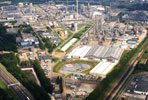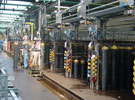

Emerson‘s PlantWeb digital plant architecture improves production at SABIC Europe.
SABIC Europe B.V. has improved the efficiency of acetylene production at its Geleen plant by 30%, thanks to tight control enabled by Emerson Process Management’s PlantWeb digital plant architecture.
SABIC Europe B.V. is part of the Saudi Basic Industries Corporation (SABIC), the largest petrochemical company in the Middle East and the fourth largest manufacturer of polyolefins worldwide. In Europe, SABIC is a major producer of both polymers and chemicals employing around 3300 people, with production facilities based in Geleen (The Netherlands), Teesside (UK), and Gelsenkirchen (Germany), annually producing 3,0 million metric tons of polyolefin and 5,7 million metric tons of chemical products like olefins, benzene, and acetylene, mainly for the European market.
Since 1975 Geleen has been home to two naphtha crackers and several polymerisation plants for the production of polyethylene and polypropylene. A by-product from these cracker processes is acetylene, which is removed and marketed throughout Europe.
To help SABIC Acetylene remain competitive in what is a difficult market, the company follows a clear strategy of being a low cost provider whilst maintaining a high quality product through operational excellence and high quality services. This requires total control of all parameters gained by fine tuning the business using key performance indicators (KPIs) monitored through a management information system (MIS).
Acetylene gas is fundamentally unstable and may explode, it is therefore shipped in special cylinders designed to keep the gas dissolved. The cylinders are packed with porous materials and then filled with acetone to half its total filling weight. When acetylene is introduced into the cylinders it dissolves into the acetone.

The filling process
At the Geleen facility, empty gas cylinders varying in type and size are refilled with acetylene. The primary objective of SABIC was to automate the processes using intelligent devices to ensure right-first-time filling. This entailed removing the possibility of any under-filling, which leads to time consuming rework or, over-filling that could result in an explosion.
The filling of the cylinders is performed in three steps. Firstly the operator places individual cylinders on a weight sensor. Man-machine-interface (MMI) terminals mounted at the filling station enable the operator to enter information pertinent to the gas cylinder being weighed. These terminals communicate with a DeltaV system using serial communication (Modbus) and the data is used to find all necessary filling set points. The operator then places the weighed cylinder into a filling rack which can hold up to 24 cylinders. When the filling rack is full, the DeltaV system calculates the amount of gas required to fill all the cylinders in the rack.
The bottle filling is fully automated using Foundation Fieldbus networked instruments including Emerson’s Micro Motion Coriolis flowmeter for direct measurement of mass flow. The real challenge was to measure a broad range of mass flow of between 0,2 and 20 kg/h at high pressures of up to 25 Bar. The Micro Motion flowmeter was able to provide a measurement of 0,35 % to 0,5% accuracy rather than the 1-2% accuracy normally associated with conventional measurement solutions. The right amount of gas is then dosed through a Foundation Fieldbus control valve, a signal light alerts the operator when the filling is complete.
Using this process, over 50 racks, each with 24 gas cylinders, are continuously filled, with handling and the administration of the filling being handled by the DeltaV system.
Upon completion of the filling phase, the third step is re-weighing the cylinders as a quality control check to ensure they have reached their target weight. When complete, the data, such as type of cylinder, customer name, gas dosed and operator is written to a PI (process historian) SQL database. Using the DeltaV system as the MIS this data is made available for management and administrators. To make it easy to generate reports and queries, a user-friendly access-application was built on top of the SQL application.
Results
In comparison with the previous manual method of weighing and filling which often required cylinders to be reworked, throughput has increased by 25%. The man hours required for the filling process has been reduced by 20% and the physical work required has been reduced considerably. With cylinders weighing up to 80 kg each there is substantial physical effort required to position them for filling. With right first time filling there is never any need for rework which would require additional handling of the cylinders. As a consequence, the safety, health and welfare of the operators have been improved.
“The use of Micro Motion Coriolis mass flowmeters ensures bottles are filled to the set point every time without exception,” said Eric Heetkamp, manager Operations and Marketing, SABIC Acetylene. “Previously, about 95% of the cylinders would have been filled correctly first time round and the operator would then have had to follow up with time consuming rework. The choice of mass flow technology combined with Foundation Fieldbus communications has proved to be an excellent investment.”
Annual savings of 300 000 Euros have been made at the filling station because of the increase in operator efficiency, reduction in the number of planned shutdowns and increased plant availability. Another major contributing factor to these cost savings is lower maintenance costs.
Maintenance and support
The acetylene filling station has very different maintenance needs than the rest of the plant at SABIC. As a result, Emerson has been awarded the contract to maintain the automation/process instrumentation. Support is required for the Foundation Fieldbus elements as well as the MIS. It is important that the filling station works at the same speed as production and the information collected from it forms the basis of monthly production reports. For this reason it is essential that there are no unexpected shutdowns and maintenance periods are kept to a minimum. SABIC’s filling plant has an excellent safety track record, and it was essential that the cooperation with Emerson completely fitted in with the safety philosophy of the filling plant, and that Emerson by its behaviour supported this record.
SABIC also wanted to keep the system up to date with life cycle management support. This includes managing: engineering changes; release status of components; con-figuration of product variations; document management; planning project resources and timescale and risk assessment. Safety is the most important criteria of SABIC’s maintenance philosophy and a regular customer/vendor relationship was deemed to be unsuitable. It was felt that a partnership relationship was more appropriate and Emerson could offer the high service levels of support SABIC desired.
Emerson Process Management provides a total care service for the site. This means that it is responsible for the complete system performance. As part of this all encompassing agreement, a 24/7 on-call service is provided for all applications and hardware, including the DeltaV system.
As a result the plant, which previously required 24 days shutdown a year, runs for a minimum of 363 days with two days scheduled for shutdowns per year. The number of unplanned shutdowns has been reduced to zero.
“In the six years since the new set-up was installed we have seen the number of jams considerably decreased,” concluded Heetkamp. “The number of unplanned plant-wide shutdowns has been reduced to zero and we have total clarity concerning the costs of maintenance.”
For more information contact Widad Haddad, Emerson Process Management Dubai, +971 4811 8100, [email protected], www.emersonprocess.com
| Tel: | +27 11 451 3700 |
| Email: | [email protected] |
| www: | www.emerson.com |
| Articles: | More information and articles about Emerson Automation Solutions |

© Technews Publishing (Pty) Ltd | All Rights Reserved